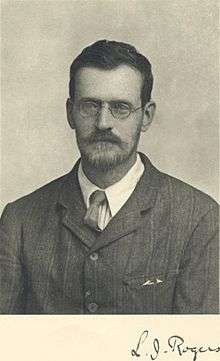Leonard James Rogers

Leonard James Rogers
Leonard James Rogers FRS[1] (30 March 1862, Oxford, England, – 12 September 1933, Oxford, England) was a British mathematician who was the first to discover the Rogers–Ramanujan identity and Hölder's inequality, and who introduced Rogers polynomials.[2] The Rogers–Szegő polynomials are named after him.
From 1888 to 1919 he was Professor of Mathematics at the Yorkshire College which became the University of Leeds in 1904.
He was elected a fellow of the Royal Society in 1924. In the late 1920s, he published in the Mathematical Gazette four notes on geometrical problems, including on Malfatti's Problem.
Publications
- Rogers, L. J. (February 1888), "An extension of a certain theorem in inequalities", Messenger of Mathematics, New Series, XVII (10): 145–150, JFM 20.0254.02, archived from the original on August 21, 2007 . The first paper containing Hölder's inequality.
- Rogers, L. J. (April 12, 1894), "Second Memoir on the Expansion of certain Infinite Products", Proceedings of the London Mathematical Society, s1, 25 (1): 318–343, doi:10.1112/plms/s1-25.1.318, JFM 25.0432.01, archived from the original on Unspecified Date Check date values in:
|archivedate=(help) . The first paper containing the Rogers–Ramanujan identities.
References
- ↑ D., A. L. (1934). "Leonard James Rogers. 1862-1933". Obituary Notices of Fellows of the Royal Society. 1 (3): 299. doi:10.1098/rsbm.1934.0013. JSTOR 768830.
- ↑ O'Connor, John J.; Robertson, Edmund F., "Leonard James Rogers", MacTutor History of Mathematics archive, University of St Andrews .
This article is issued from
Wikipedia.
The text is licensed under Creative Commons - Attribution - Sharealike.
Additional terms may apply for the media files.